#i have no idea for walter whites aspect but i feel like prince is a good class
Text
walter white and mike are character foils but its mostly bc walter white wants to be everyones dad but he fucing sucks at it and mike just wants to live his girlboss life but tortured young men with sad wet eyes keep materializing in front of him and he just sighs and goes 'okay let me help'
#daphnes talking again#AAAA WAIT THE DIFFERENCE BTWN ACTIVE AND PASSIVE HOLY SHIT#im thinking that mike is a void player. that would vibe for me.#not sure what class but void seems right#i have no idea for walter whites aspect but i feel like prince is a good class#bc like. destroyer. it uh. vibes#ill have to pour over my clsspecting notes again if i wanna classpect them tho#anyway.#brba
21 notes
·
View notes
Quote
And the Kantian Imperative? To tell the truth, I didn’t have much of an idea, I had told poor Eichmann pretty much whatever came into my head. In the Ukraine or in the Caucasus, questions of this kind still concerned me, difficulties distressed me and I discussed them seriously, with the feeling that they were a vital issue. But that feeling seemed to have gotten lost. Where, when did that happen? In Stalingrad? Or afterward? For a while I thought I had drowned, submerged by the things resurfaced from the depths of my past. And then, with the stupid, incomprehensible death of my mother, this anguish too had disappeared: the feeling that dominated me now was a vast indifference—not dull, but light and precise. Only my work engaged me; I felt I had been offered a stimulating challenge that would call on all my abilities, and I wanted to succeed—not for a promotion or for any ulterior ambitions, I had none, but simply to enjoy the satisfaction of a thing well done. It was in this state of mind that I left for Poland, accompanied by Piontek, leaving Fräulein Praxa in Berlin to see to my mail, my rent, and her nails. I had chosen a good time to begin my trip: my former superior in the Caucasus, Walter Bierkamp, was replacing Oberführer Schöngarth as BdS of the Generalgouvernement, and, having learned this from Brandt, I had gotten myself invited to the presentation ceremony. This took place in mid-June 1943, in Cracow, in the inner courtyard of the Wawel Castle, a magnificent building, even with its tall, thin columns hidden beneath banners. Hans Frank, the Generalgouverneur, gave a long speech from a platform set up in the rear of the courtyard, surrounded by dignitaries and by an honor guard. He looked a little ridiculous in his brown SA uniform with his tall stovepipe cap, the strap of which cut into his jowls. The crude frankness of the speech surprised me, I still remember, since there was a considerable audience there, not just representatives from the SP and the SD, but also from the Waffen-SS, civil servants in the GG, and officers from the Wehrmacht. Frank congratulated Schöngarth, who stood behind him, stiff and a head taller than Bierkamp, on his successes in the implementation of difficult aspects of National Socialist ideology. This speech has survived in the archives; here’s an extract that gives a good idea of the tone: In a state of war, where victory is at stake, where we are looking eternity in the face, this is an extremely difficult problem. How, it is often asked, can the need to cooperate with an alien culture be reconciled with the ideological aim of, say, wiping out the Polish Volkstum? How is the need to maintain industrial output compatible with the need, for example, to annihilate the Jews? These were good questions, yet I found it surprising that they were so openly aired. A GG civil servant assured me later on that Frank always spoke this way, and that in any case in Poland the extermination of the Jews wasn’t a secret for anyone. Frank, who must have been a handsome man before his face drowned in fat, spoke with a powerful but squeaky, almost hysterical voice; he kept rising on his toes, stretching his paunch over the podium, and waving his hand. Schöngarth, a man with a tall, square forehead, who spoke in a calm, somewhat pedantic voice, also gave a speech, followed by Bierkamp, whose National Socialist proclamations of faith I couldn’t help myself from finding a little hypocritical (but I probably found it hard to forgive the dirty trick he’d played on me). When I came up to congratulate him during the reception, he acted as if he were delighted to see me: “Sturmbannführer Aue! I heard you behaved heroically, in Stalingrad. My congratulations! I never doubted you.” His smile, in his little otter face, looked like a grimace; but it was entirely possible that he had in fact forgotten his last words in Voroshilovsk, which were hardly compatible with my new situation. He asked me some questions about my duties and assured me of the complete cooperation of his departments, promising me a letter of recommendation to his subordinates in Lublin, where I counted on beginning my inspection; he also told me, over a few drinks, how he had brought Group D back through Byelorussia, where, renamed Kampfgruppe Bierkamp, it had been assigned to the anti-partisan fight, especially north of the Pripet Marshes, taking part in the major cleansing operations, like the one code-named “Cottbus” that had just ended at the time of his transfer to Poland. About Korsemann, he whispered to me in a confidential tone that he had acted poorly and was on the point of losing his position; there was talk of putting him on trial for cowardice in the face of the enemy, he would at the very least be stripped of his rank and sent to redeem himself at the front. “He should have followed the example of a man like you. But his indulgence toward the Wehrmacht has cost him dearly.” These words made me smile: for a man like Bierkamp, obviously, success was everything. He himself hadn’t done too badly; BdS was an important position, especially in the Generalgouvernement. I didn’t mention the past, either. What counted was the present, and if Bierkamp could help me, so much the better.
I spent a few days in Cracow, to go to meetings and also to enjoy this beautiful city a little. I visited the old Jewish quarter, the Kasimierz, now occupied by haggard, sickly, and unkempt Poles, displaced by the Germanization of the Incorporated Territories. The synagogues hadn’t been destroyed: Frank, they said, wanted some material traces of Polish Judaism to survive, for the edification of future generations. Some served as warehouses, others remained closed; I had the two oldest ones opened for me, around the long Szeroka Square. The so-called Old Synagogue, which dated back to the fifteenth century, with its long crenellated-roof annex added for women in the sixteenth or early seventeenth century, served the Wehrmacht to store food supplies and spare parts; the brick façade, many times remodeled, the blocked windows, white limestone arches, and somewhat randomly set sandstone blocks had an almost Venetian charm, and owed much to the Italian architects working in Poland and Galicia. The Remuh Synagogue, at the other end of the square, was a small, narrow, sooty building of no architectural interest. But of the large Jewish cemetery surrounding it, which would certainly have been worth the trouble of visiting, nothing more remained but a vacant, desolate lot; the old gravestones had been taken away as construction material. The young officer from the Gestapostelle who accompanied me knew the history of Polish Judaism very well, and showed me where the grave of Rabbi Moses Isserles, a famous Talmudist, had been. “As soon as Prince Mieszko began to impose the Catholic faith on Poland, in the tenth century,” he explained, “the Jews appeared to sell salt, wheat, furs, wine. Since they made the kings richer, they obtained franchise after franchise. The people, at that time, were still pagan, healthy and unspoiled, apart from a few Orthodox Christians to the East. So the Jews helped Catholicism implant itself on Polish soil, and in exchange, Catholicism protected the Jews. Long after the conversion of the people, the Jews kept this position of agents of the powerful, helping the pan bleed the peasants by every means possible, serving them as bailiffs, usurers, holding all commerce firmly in their hands. Hence the persistence and strength of Polish anti-Semitism: for the Polish people, the Jew has always been an exploiter, and even if the Poles hate us profoundly, they still approve of our solution to the Jewish problem from the bottom of their hearts. That’s also true for the supporters of the Armia Krajowa, who are all Catholics and bigots, even if it’s a little less true for the Communist partisans, who are forced, sometimes against their will, to follow the Moscow Party line.”—“But the AK sold weapons to the Jews in Warsaw.”—“Their worst weapons, in ridiculous quantities, at exorbitant prices. According to our information, they agreed to sell them only on direct orders from London, where the Jews are manipulating their so-called government in exile.”—“And how many Jews are left now?”—“I don’t know the exact number. But I can assure you that before the end of the year all the ghettos will be liquidated. Aside from our camps and a handful of partisans, there won’t be any more Jews left in Poland. Then it will finally be time to look seriously into the Polish question. They too will have to submit to a major demographic diminution.”—“Total?”—“I don’t know about total. The economics departments are in the process of studying it and making calculations. But it will be sizeable: the overpopulation is far too important. Without that, this region can never prosper or flourish.”
Jonathan Littell “Les Bienveillantes”
#books#jonathan littell#les bienveillantes#las benevolas#as benevolentes#poland#the furies#the kindly ones
1 note
·
View note
Text
Discover A World of Stories at Edinburgh’s Storytelling Festival
It was a chilly autumn morning in Edinburgh, and I was late for the Storytelling Festival.
I wove my way past groups of tourists along the Royal Mile until I reached a slightly crooked corner building – painted white on one side, bare brick on the other. I rushed up the stairs of the Scottish Storytelling Centre and suddenly stood inside a warm cafe, where my glasses steamed up immediately.
I looked around and spotted a white-haired man with eagles outlined on his shirt: Robert Seven Crows Bourdon, the man I was supposed to meet. Robert, a singer, songwriter and professional storyteller hailing from Quebec, was my first introduction to the reason for me being in Edinburgh.
We were both there for the Scottish International Storytelling Festival – otherwise known as the best festival I’ve never heard of.
Wait – there’s a Storytelling Centre in Edinburgh?
You’d be forgiven for not noticing the Scottish Storytelling Centre at first glance – it blends seamlessly into the other historical buildings along the Royal Mile. But for me (and for any other story-obsessed folk), this place is a dream location.
The Scottish Storytelling Centre is an arts venue designed specifically to preserve and celebrate live oral storytelling. It’s the first place in the world to do this – and probably just one of a handful of similar centres worldwide.
Throughout the year, the centre holds numerous events – everything from spoken word performances and open mic nights to workshops and exhibitions – but each October it becomes an international hub as storytellers from all over the world flock to the Scottish International Storytelling Festival.
So what is the Scottish International Storytelling Festival?
The Scottish International Storytelling Festival began in 1989 with the intention of bringing storytellers together to share oral histories and traditions. It’s been running for the last three decades, and celebrated its 31st iteration this year.
More than sixty events take place over the twelve day festival, and although the majority are held at the Storytelling Centre, there’s also associated talks and exhibitions scattered throughout Edinburgh too.
The theme of this year’s 2019 festival was ‘Beyond Words’, which showcased how music, dance and song all share their own stories. It also focused specifically on storytellers from First Nation Canada: something of a coincidence, seeing as I’d just spent a fortnight in Atlantic Canada with First Nation Mi’kmaq people learning about their traditions.
It also meant I was fascinated to know more about how Robert’s First Nation ancestry influences his storytelling.
Read more: a fortnight spent exploring Atlantic Canada
“Storytelling performances are a big trend now,” Robert told me. He said that oral storytelling is becoming more like theatre, where the focus is on the ‘show’ instead of the rapport between speaker and listener.
At a festival, everyone’s sitting and waiting with bated breath, but the tradition he comes from treats storytelling as something effortless. Nobody has stage fright; nobody’s afraid to disappoint.
“In our world there’s dogs running around, there’s kids jumping over you, the elders are talking…It’s not a performance. I invite you into my world — but I’m not saying you must listen to me. The storyteller’s job is not to be listened to. His job is to tell.”
Over the next hour, we talked about the other storytelling festivals he’s performed at (and there are many – Robert’s been telling stories professionally for twenty years). I’ve been to a few literary festivals – the most memorable being Hay Book Festival in Wales and Gibraltar’s annual Literary Festival – but Edinburgh’s Storytelling Festival is the first I’ve heard of which explores the relationship between a storyteller and their audience.
Before I’d even attended a performance, Robert’s words were making me understand just how significant this festival was.
Read more: Sailing to the Arctic in pursuit of storytelling
Exploring Edinburgh’s literary side
The skies were still bright blue outside on the Royal Mile. I had a few hours before attending my first performance of the storytelling festival, so I decided to visit a few of the more famous literary landmarks in the city.
Edinburgh’s fame as a literary destination is unparalleled. It was deemed the world’s first UNESCO City of Literature in 2004; it holds the largest literary festival in the world; and it’s regarded by millions as the modern-day home of schoolboy magic, thanks to J.K. Rowling’s regular writing sessions in an Edinburgh cafe.
It feels like you can’t take more than a few steps through Edinburgh without passing a second-hand bookshop, a location featured in a novel, or posters like these plastered all over the bricks.
My self-guided literary tour of Edinburgh began at The Writers Museum where three of Scotland’s most famous writers are celebrated: Robert Burns, Walter Scott and Robert Louis Stevenson.
Once I’d climbed up a winding red staircase in a narrow tower at Makar’s Court, I found glass cabinets filled with their childhood toys, dusty clothes, tobacco pipes, chess sets and locks of their hair.
At the National Library of Scotland, I wandered through an exhibit on how Scottish people have changed the world – and then spent ages in front of a glass cabinet filled with paper sculptures from old books.
These stunning artworks mysteriously appeared one night in 2011, left by an anonymous female sculptor in various cultural locations around Edinburgh. More sculptures were revealed over the next five years – but although the project has now come to a close, the artist’s identity still remains a secret.
I even made a quick stop at Deacon Brodie’s Tavern, the namesake of which served as the inspiration for ‘The Strange Case of Dr Jekyll and Mr Hyde‘.
A furniture maker and city councillor by day but a thief by night, the errant Deacon Brodie swung from the gallows in 1788. Some of his furniture made its way to a young Robert Louis Stevenson’s family: the burgeoning author became fascinated with Brodie’s double life, eventually incorporating the character into one of his most well-known novels.
By the time the sun had set, it was time to venture back to the Storytelling Centre for my first festival performance.
Inside the Scottish Storytelling Centre
A crowd of excited attendees were already milling around the Storytelling Court when I stepped inside. I headed for the ‘interactive storytelling wall’ – a long row of cabinet doors containing tiny, perfect models of famous stories, legends and folk tales.
After opening a few, I found a scene depicting Flora MacDonald helping Bonnie Prince Charlie escape to the Isle of Skye. She’s one of the famous Floras I was named after, and I couldn’t help but smile!
Just then the theatre doors were opened so I headed downstairs to the Netherbow Theatre, a small auditorium with just 99 seats, to watch as the Dancers of Damelahamid appeared onstage.
An Indigenous dance company from the northwest coast of British Columbia, they draw inspiration from their origin stories and use masks to retell traditional narratives of their ancestors. I had no idea what to expect, but from the moment their performance began I was utterly enthralled.
Their movements were quiet. Almost silent. Clean and precise, their feet tapping as they stepped back and forth to a drum beat. They uttered no words and were fully absorbed in their dance; becoming birds with beaks, then shaking wooden rain sticks and gripping animal hooves in their hands. Then suddenly:
“IT’S A SHARK!!”
A young child’s gleeful voice rang out from behind me. I felt the audience twitch and stiffen: my immediate reaction was one of annoyance, and I began mentally preparing for the constant threat of disturbance.
But that’s when Robert’s words came back to me: “Storytelling isn’t supposed to be silent or one-sided!” For him, any moment of storytelling will involve possible noise and outside activity and distraction.
And in that moment, I realised I’d been looking at this festival all wrong.
So often I think about storytelling as being something static – something to be read either on the page or a device’s screen. But in fact it’s so important to remember the live aspect of storytelling. The relationship between an oral storyteller and their audience has such power because it’s so subject to changes in timing, volume, even the dynamic between the people involved.
But everything – even a child’s excitable reactions – are simply part of the overall experience.
A spooky storytelling marathon for Halloween
The next day was the last of the storytelling festival, which also coincided with Halloween. I spent the majority of my day at the centre where a steady stream of impromptu storytellers stood (or sat) to share their words.
Just like Robert had said, the beauty of this event was in the interactive aspect. I watched a dozen different people take centre stage: a girl from Poland, an elderly Irish man, a Belgian woman, a guy in a full Scottish kilt outfit, all of whom told spooky stories.
Every time I thought of leaving, a new character appeared on stage and I couldn’t go – particularly when a group of older Scottish gentlemen arrived. They clearly spend a lot of time at the centre: there was an easy camaraderie between them borne of years in each others company, and their enjoyment of each others’ stories was infectious.
Celebrating a different kind of story at Samhuinn Fire Festival
Later that night, I wrapped myself in all the clothes I’d brought with me and trudged up Calton Hill to a side of Edinburgh which seemed lifted from the pages of a folk tale.
That’s because Halloween is celebrated differently in Scotland. October 31st is the night of Samhuinn, an ancient pagan festival which welcomes the thinning of the veil between two worlds. And each year, the Beltane Fire Society hold a festival to celebrate Samhuinn tradition with immersive performance, drumming, acrobatics and fire.
Read more: celebrating Samhuinn Fire Festival in Edinburgh
The value of storytelling
As I stood amongst the crowds and watched a grinning group of costumed characters dance and spin their way across the hilltop, I thought about how many ways there truly are to tell a story. It doesn’t prescribe to any one medium: it can be dancing or singing, drumming or speaking, full of sound or completely silent.
It’s about the rhythms they choose to use: cadence, words, the lilt of their voice. It’s about the place they decide to perform: sitting amongst their audience or standing on a stage or weaving their way through a small, tight crowd.
There is always a place for stories, and for storytellers – and in Edinburgh there’s a literal building for it. I’d never heard of Edinburgh’s Storytelling Centre before this visit, but I’m so thankful I know about its existence now. Creating a real, physical space for storytellers to gather together – not to mention hosting a festival which celebrating those gatherings, and opens them up for others – is something pretty special in my book.
Pin this article if you enjoyed it!
NB: This trip was in paid partnership with Edinburgh Festivals, who kindly invited me to the Scottish International Storytelling Festival so I could wax lyrical about stories for a weekend.
The post Discover A World of Stories at Edinburgh’s Storytelling Festival appeared first on Flora The Explorer.
via WordPress https://ift.tt/2QWEuy9
0 notes
Text
From Above
How can you see all the angles of a town? Of course you can’t, at least not at the same time – but you can keep trying, keep gathering, keep learning.* I’m trying to build up a multidimensional picture layer by layer - a map of Dumfries that isn't flat, but is rather like a portrait that grows from many angles. I've been trying to find the best 'way in' to this portrait, sketching a rough outline before properly beginning to flesh out the details.
I wanted some kind of overview, starting with a way to photograph for myself something like the aerial view of Dumfries that I’d seen on Google and Bing maps. From memory, I’d at first thought that the steep downhill on the way in from Castle Douglas (the Glen), might have somewhere with a good view from above where I could park and photograph - but no, on the A75 the obligatory planted mixed native deciduous roadside trees are now old enough to be a beautiful screen of green in this season.
Then I remembered the Camera Obscura. I’ve only ever been a few times, most recently I think 17 years ago when my youngest daughter was a baby who didn’t like the heat of summer or the confusion of bustling strangers, so my mum helped my 4 year old to see while I sat out of the way, baby-calming. And before that, when I was a child myself (and probably too shy to get close enough to see properly!). So this visit was really an enormous treat – I’d told the museum staff in advance that I was coming and why, and by luck I was the only visitor, so the views were all mine…
I’m led upstairs by Susan the Gallery Attendant, past exhibits on the first floor, then up the spiral staircase, our footsteps sounding on wooden steps winding around a wooden post (which had originally been a ship’s mast and which may have been part of the building when it was a windmill, and which has to slant slightly from upright in order for the steps of the spiral staircase to maintain the same tread all the way up…)
There are so many fantastic stories attached just to this building - this link contains many of them (I almost want to do a whole poetry pamphlet on just this tower). An excerpt:
‘In the autumn of 1834 there were proposals afoot to demolish the old windmill which stood at the top of Corbelly Hill and redevelop the site. This met considerable opposition and Robert Thomson, shipowner, shipbuilder merchant and pioneer of trade with New Brunswick and Prince Edward Island, circulated a printed subscription form round the town -
"The spirit of commercial enterprise respects not objects, however picturesque and as the fate of the building has thus been decreed, nothing can save it but union and exertion on the part of those to whom it is nearly as dear as the Nith itself. In every part of the world there are Dumfriesians who remember well the Corbelly Hill with the mill, the kiln and the cozie seat which this latter afforded them in a winter day, the huge reefed arms that expanded above and the long and broad shadows they incessantly cast when the wind was strong and the weather fine, It is proposed therefore to form an Association under the name of the Dumfries and Maxwelltown Astronomical Society".
One of their principal aims was "That a Telescope and a Camera Obscura be purchased as soon as the necessary funds can be raised"’.
There is much more to this story, but I feel very glad that the plan succeeded and the camera obscura which opened to the public on 1st August 1836 is still intact and working wonderfully.
We pause on the second floor and Susan takes me to the windows to show me landmarks which will help me orientate – I laugh nervously, that yes, I’m not that great at knowing where things are in relation to each other. There’s also just been the upward journey by windowless spiral staircase which could be a tiny bit like being blindfolded and spun round in ‘Blind Man’s Buff’...
She points out the flag outside on a flagpole, and yes, there’s the pointy top of the Cuckoo Bridge towards the A76 (about a mile NNW), there’s the Midsteeple (much closer, NNE), the Church Street chimneys (just along the road), Palmerston stadium. She shows me the information boards on this floor that tell the story of the building, the bust of Robert Thomson, the man who bought and saved the building in 1834, and the life-size figure of Walter Newall, the architect who designed the conversion of the windmill tower into an observatory and supervised the work.
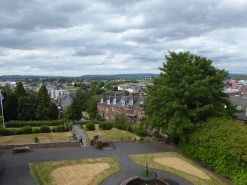

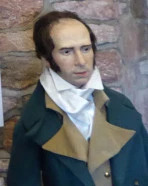
We carry on up the spiral stairway to the very top, where we're faced by a curved door (apparently a speciality of the architect), which Susan unlocks before showing me in. The room is smaller than I remember (of course), darkened and cosy, though a fan is cooling it in this unusual current hot spell. There is a guard rail around the table-like white dish where the image will be projected and ropes which operate the lens and mirror above hang down from a circular gap in the ceiling. One rope opens the lid which protects the apparatus from the weather, another adjusts the mirror which reflects an image down through a lens and a third rotates the turret through 360 degrees so that the views can be seen in any direction. The image is brought into focus by raising or lowering the projection table which has a counterweight below for this purpose, between the two floors. Susan lets me adjust this myself to feel the working of the mechanism, which is very satisfying - another beautifully conceived and built device.
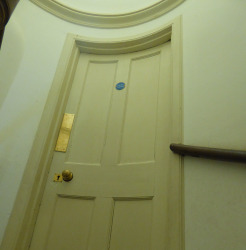
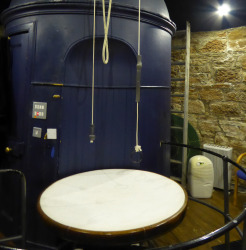
The light is switched off, the mirror tilted and the image brought into focus. We start close in at the museum's front gate, Susan again pointing out the landmarks we'd seen from the window below and some new ones - the flag outside, the Crichton Church spire, the hazy view across the Solway to the Lake District... We progress around the town all the way around, from close views to distant.
The perspective is very fresh from here, the familiar made unfamiliar, and as I remember from childhood, maybe the oddest thing is to see movement; cars and buses on roads, people walking. Although of course I knew it was a live image, this still feels unreal and the dark room, the circular image with us leaning over it does have a slightly witchcrafty feel, the vivid scene both a trick of the light and a true feed from the outside world. I'd love to be able to see the first images projected in 1836 and the faces of the viewers (initially elite viewers, eventually in 1849, the paying public, but only on Saturdays).
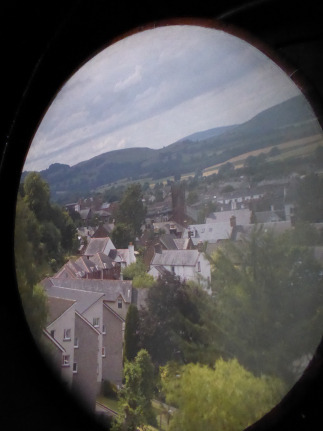
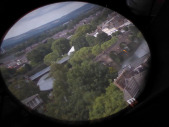


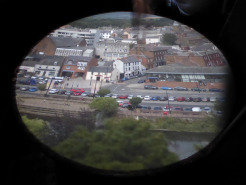
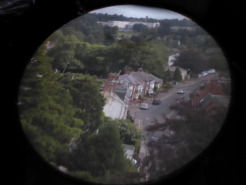
Again from this link, when the observatory first opened:
'The newspaper reported that "when the Telescope was pointed to the lower part of the town, a lady was seen sitting at her window reading a letter, and when this was mentioned, Mr Morton remarked that by putting in the most powerful glass, he could enable the beholder to read the letter too. This, however, was not done, and if the Directors can help it, it will never be attempted. When the strongest glass was tried placards were read on the walls of Mr Rankine's and other shops near the Old Bridge". As for the Camera Obscura - "the colouring is as perfect as the eye could desire, and as the weather on Saturday was breezy in the extreme, it was beautiful to observe huge masses of river water chafed into foam as it hurried along. But it would be endless to record all the pleasure the Camera table affords, let our town readers therefore cross the bridge and judge for themselves, under the firm conviction that even the walk will do them good".'
I've certainly gained some new perspective here, both into Dumfries now and in the past - for example, when the Observatory opened, this area overlooked Dumfries but was not yet part of the town. I'm surprised too by how green the town looks from above, how many trees there are - one idea I'd had was to have a Dumfries version of the Edinburgh Tree Map, but I now realise this would be a much bigger task than I thought!
Back downstairs, I wish I had more time to view the museum's wonderful exhibits [I'd highly recommend visiting the museum and camera obscura for yourself, both are really amazing and the staff are friendly and informative - more information here and here].
I return to the slabs of sandstone on the ground floor which have Permian period fossil footprints, discovered locally during the same flourish of scientific interest and activity in which the observatory came about. If I want to really know who Dumfries is, maybe I need to return first to what it is made of - the stone, the water, the weather...
*A really excellent resource for me to quickly and enjoyably fill in much detail in many aspects of Dumfries’s history has been the newly published Secret Dumfries by Mary Smith and Keith Kirk, published by Amberley - well worth checking out!
Deep Mapping Dumfries on Wordpress here.
#dumfries#deep mapping#deep mapping dumfries#dumfries museum#camera obscura#dumfries and galloway#psychogeography#scotland#photography#writing#writers#placemaking#poetry#prose
0 notes